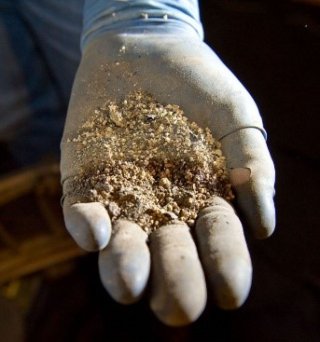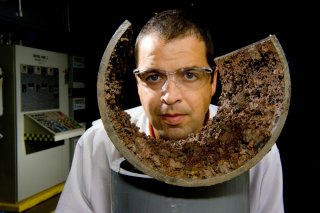EPA Research Supports National Lead Poisoning Prevention Week
Behind the Science Helping Prevent Lead Poisoning

Each year, EPA joins the U.S. Department of Housing and Urban Development (HUD), the Centers for Disease Control and Prevention (CDC), and other partners to celebrate National Lead Poisoning Prevention Week—a call to reduce childhood exposure to lead and to prevent lead poisoning. The goal of the week is to share ways parents can reduce children’s exposure to lead in their environment.
Supporting parents—along with doctors and nurses, daycare providers, teachers, and other caregivers—by providing them with science-based information, tools, and other resources to protect children from lead is also a major priority of EPA’s lead research.
We invite you to explore the recent highlights below featuring the EPA science behind reducing lead exposure and poisoning.
Mapping Lead Hotspots

While blood lead levels overall have dropped significantly in recent decades, certain communities still face disproportionate exposure risks. Unfortunately, data gaps have all too often masked exactly where these communities are located across the larger landscape, preventing action and leaving the children who live there at greater risk to serious health effects, including lead poisoning.
EPA researchers are working to change that. In an innovative, multi-disciplinary, cross federal government research effort, they are combining childhood blood level data, lead data mapping, and statistical modeling to pinpoint areas at the census level scale with a high prevalence of elevated childhood lead levels. They are also using what they learn to develop a “blueprint” to aid their partners in EPA Regions and states to build their own capacity to conduct similar analyses and guide preventative actions.
This work will help EPA continue to advance its data analysis and mapping science for lead so that states and communities have the information they need to target and prioritize actions to reduce, prevent, and mitigate lead exposure risk, particularly for children.
Lead Modelling

Agency researchers are developing and applying a suite of lead exposure and blood lead estimation models to meet the specific needs of those on the front lines of developing and employing actions to better protect people from lead exposures.
Researchers recently updated three models and evaluated them with environmental and blood lead data from EPA's Superfund program and from the Centers for Disease Control and Prevention and states. The three models are:
- Integrated Exposure Uptake Biokinetic Model (IEUBK)
- All-Ages Lead Model (AALM)
- Stochastic Human Exposure and Dose Simulation Multimedia Model for Lead (SHEDS-Pb)
Researchers continue to support and publish research on these models and on critical modeling parameters such as soil and dust ingestion and respiratory particle deposition.
Innovative Ways to Treat Lead in Soil

Our researchers are developing new ways to clean up lead in contaminated sites, where lead-tainted soils can be both pervasive and long-lasting routes of exposure.
In one promising study, they have patented a method of transforming soil lead to a plumbojarosite mineral complex which binds up lead chemically, decreasing its bioaccessibility (the ability of the body to absorb) by approximately 90%. Further research across various spatial and temporal scales is underway to fully understand the utility of this technology for lead remediation. Continued success offers the potential to provide highly efficient, low-cost alternatives that can be used on-site.
Protecting Drinking Water

Keeping lead out of our drinking water is a critical part of preventing exposures and reducing health risks to children and others. EPA researchers are working to help communities, drinking water utilities, and other partners to address challenges related to potential sources of lead that can leach into drinking water, such as lead service lines, fixtures, and corrosion from pipe deposits.
For example, our researchers have developed water sampling methods that identify where lead service lines are located. This work is helping utilities pinpoint where digging and pipe replacements should be targeted, simultaneously reducing costs and accelerating the pace of needed pipe replacements. In other projects, they are continuing to support local water systems through research, technical support, and training—adapting methods and procedures to optimize corrosion control that match local conditions (climate, season, and water chemistry) and minimize the risk of lead leaching into the water as it flows.
Our researchers are also supporting communities like the City of Benton Harbor, MI, where in 2018 lead levels in the drinking water supply sparked health concerns. In response, the Michigan Department of Health and Human Services (MDHHS), through the Berrien County Health Department (BCHD), distributed faucet-mounted and pitcher filters to reduce the level of lead in tap water. EPA researchers coordinated three studies along with local partners (MDHHS; the Michigan Department of Environment, Great Lakes, and Energy; BCHD; the City of Benton Harbor; and Lake Michigan College). The studies helped to ensure residents that the filters, when properly installed and used, removed lead from drinking water as expected.
Unleaded Air: EPA’s Lead Integrated Science Assessment

EPA research provides the scientific foundation for National Ambient Air Quality Standards (NAAQS) for lead, designated as one of six criteria air pollutants. The Clean Air Act requires Agency scientists to periodically review these standards through the comprehensive Lead Integrated Science Assessment (ISA). The assessment is a synthesis evaluation of the “most policy relevant science that forms the scientific foundation for the primary (health-based) and secondary (welfare-based) national ambient air quality standards for Lead (Pb).”
The Agency recently announced the availability of the 2023 External Review Draft of the Lead (Pb) Integrated Science Assessment (ISA). It outlines key policy-relevant conclusions, including those on the populations at increased risk of lead-related effects, the lead exposure concentrations at which such effects occur, and the overall strength of the evidence supporting relationships between lead exposures and health or welfare effects. The Clean Air Scientific Advisory Committee reviewed the draft assessment, providing comments that will strengthen the final version. Agency researchers are currently revising the document and plan to release the Final Lead (Pb) ISA in 2024.
Sources & Citations
Mapping Lead Hotspots
Xue, J., Zartarian, V., Tornero-Velez, R., Stanek, L. W., Poulakos, A., Walts, A., Triantafillou, K., Suero, M., & Grokhowsky, N. (2022). A Generalizable Evaluated Approach, Applying Advanced Geospatial Statistical Methods, to Identify High Lead Exposure Locations at Census Tract Scale: Michigan Case Study. Environmental health perspectives, 130(7), 77004. https://doi.org/10.1289/EHP9705
Zartarian V, Poulakos A, Garrison VH, Spalt N, Tornero-Velez R, Xue J, Egan K, Courtney J. Lead Data Mapping to Prioritize US Locations for Whole-of-Government Exposure Prevention Efforts: State of the Science, Federal Collaborations, and Remaining Challenges. Am J Public Health. 2022 Sep;112(S7):S658-S669.
Lead Modelling
Brown, J. S., Spalinger, S. M., Weppner, S. G., Hicks, K. J. W., Thorhaug, M., Thayer, W. C., Follansbee, M. H., & Diamond, G. L. (2022). Evaluation of the integrated exposure uptake biokinetic (IEUBK) model for lead in children. Journal of exposure science & environmental epidemiology, 10.1038/s41370-022-00473-2. Advance online publication. https://doi.org/10.1038/s41370-022-00473-2
Brown, JS, Diamond, GL (2023). Derivation of first-order dissolution rates to estimate particle clearance and burden in the human respiratory tract. Particle and Fiber Tox 10: 17 https://doi.org/10.1186/s12989-023-00523-z
Hubbard, H., Özkaynak, H., Glen, G., Cohen, J., Thomas, K., Phillips, L., & Tulve, N. (2022). Model-based predictions of soil and dust ingestion rates for U.S. adults using the stochastic human exposure and dose simulation soil and dust model. The Science of the total environment, 846, 157501. https://doi.org/10.1016/j.scitotenv.2022.157501
Özkaynak, H., Glen, G., Cohen, J., Hubbard, H., Thomas, K., Phillips, L., & Tulve, N. (2022). Model based prediction of age-specific soil and dust ingestion rates for children. Journal of exposure science & environmental epidemiology, 32(3), 472–480. https://doi.org/10.1038/s41370-021-00406-5
Zartarian, V.G., Xue, J., Gibb-Snyder, E., Frank, J.J., Tornero-Velez, R., Stanek, L.W. (2023) Children's lead exposure in the U.S.: Application of a national-scale, probabilistic aggregate model with a focus on residential soil and dust lead (Pb) scenarios. Science of The Total Environment Volume 905, 20 December 2023, 167132 https://doi.org/10.1016/j.scitotenv.2023.167132
Innovative Ways to Treat Lead in Soil
George, S., J. James, R. Devereux, Y. Wan, G. Diamond, K. Bradham, K. Scheckel, AND D. Thomas. Ingestion of Remediated Lead-Contaminated Soils Affects the Fecal Microbiome of Mice. SCIENCE OF THE TOTAL ENVIRONMENT. Elsevier BV, AMSTERDAM, Netherlands, 837:155797, (2022). https://doi.org/10.1016/j.scitotenv.2022.155797
Kastury, F., Li, H., Karna, R. et al (2023). Opportunities and Challenges Associated with Bioavailability-Based Remediation Strategies for Lead-Contaminated Soil with Arsenic as a Co-Contaminant—A Critical Review. Curr Pollution Rep 9, 213–225 (2023). https://doi.org/10.1007/s40726-023-00252-z
Plunkett, SA, Eckley, CS, Luxton, TP, Johnson, MG (2022). The effects of biochar and redox conditions on soil Pb bioaccessibility to people and waterfowl, Chemosphere, Volume 294, 2022, 133675, ISSN 0045-6535, https://doi.org/10.1016/j.chemosphere.2022.133675
Plunkett, SA, Eckley, CS, Luxton, TP, Johnson, MG (2022). The effects of biochar and redox conditions on soil Pb bioaccessibility to people and waterfowl, Chemosphere, Volume 294, 2022, 133675, ISSN 0045-6535, https://doi.org/10.1016/j.chemosphere.2022.133675.
Scheckel, KG, Karna, RR, Partridge, CR, Bradham, KD, Thomas, DJ, Noerpel, MR, Goetz, JL, Luxton, TP (2022). Method for sequestering ions in an environmental matrix. US Patent no. 11414334.
Scheckel, KG, Karna, RR, Partridge, CR, Bradham, KD, Thomas, DJ, Noerpel, MR, Goetz, JL, Luxton, TP, Sowers, TD. (2022). Method for sequestering ions in an environmental matrix. US Patent no. 20220355353.
Sowers TD, Blackmon MD, Bone SE, Kirby AM, Jerden ML, Noerpel MR, Scheckel KG, Bradham KD (2022). Successful Conversion of Pb-Contaminated Soils to Low-Bioaccessibility Plumbojarosite Using Potassium-Jarosite at Ambient Temperature. Environ Sci Technol. 2022 Nov 15;56(22):15718-15727.
Tucillo, ME, Blue, J, Koplos, J, Kelly, J, Wilkin, RT (2023). Complexities in attributing lead contamination to specific sources in an industrial area of Philadelphia, PA. Heliyon https://doi.org/10.1016/j.heliyon.2023.e15666
Wan, Y, Devereux, R, George, SE, Chen, J, Gao, B, Noerpel, M, Scheckel, K (2022). Interactive effects of biochar amendment and lead toxicity on soil microbial community, Journal of Hazardous Materials, Volume 425,2022,127921,ISSN 0304-3894, https://doi.org/10.1016/j.jhazmat.2021.127921.
Ye, D., Brown, J. S., Umbach, D. M., Adams, J., Thayer, W., Follansbee, M. H., & Kirrane, E. F. (2022). Estimating the Effects of Soil Remediation on Children's Blood Lead near a Former Lead Smelter in Omaha, Nebraska, USA. Environmental health perspectives, 130(3), 37008. https://doi.org/10.1289/EHP8657
Protecting Drinking Water
Bradham, K.D., Nelson, C.M., Sowers, T.D. et al. (2023) A national survey of lead and other metal(loids) in residential drinking water in the United States. Journal of Exposure Science & Environmental Epidemiology (2023) 33:160–167; https://doi.org/10.1038/s41370-022-00461-6
Burkhardt, JB, Woo, H, Mason, J, Shang, F, Triantafyllidou, S, Schock, MR, Lytle, D, Murray, R (2022). Closure to “Framework for Modeling Lead in Premise Plumbing Systems Using EPANET” J Water Resources 148(2) https://doi.org/10.1061/(ASCE)WR.1943-5452.0001304
Devine, C. AND Triantafyllidou, S (2023). A Literature Review of Bench Top and Pilot Lead Corrosion Assessment Studies. AWWA Water Science. John Wiley & Sons, Inc., Hoboken, NJ, 5(2):e1324, (2023). https://doi.org/10.1002/aws2.1324
Harmon SM, Tully J, DeSantis MK, Schock MR, Triantafyllidou S, Lytle DA. A holistic approach to lead pipe scale analysis: Importance, methodology, and limitations. AWWA Water Sci. (2022) Mar 17;4(2):0. doi: 10.1002/aws2.1278. PMID: 35586783; PMCID: PMC9112127.
Liggett, J., Baribeau, H, Deshommes, E, Lytle, D, Masters, S, Muylwyk, Q, and Triantafyllidou, S. (2022). Service Line Material Identification: Experiences from North American Water Systems. Journal AWWA. American Water Works Association, Denver, CO, 114(1):8-19. https://doi.org/10.1002/awwa.1841
Tang, M, Lytle, D, Achtemeier, R, Tully, J (2023). Reviewing performance of NSF/ANSI 53 certified water filters for lead removal. Water Research 244 (2023) 120425. https://doi.org/10.1016/j.watres.2023.120425
Triantafyllidou S, Wasserstrom L, Nelson J, Webb D, Formal C, Doré E, Lytle D. Lead in synthetic and municipal drinking water varies by field versus laboratory analysis (2023). Sci Total Environ. 2023 Sep 15;891:163873. doi: 10.1016/j.scitotenv.2023.163873. Epub 2023 May 23. PMID: 37230337.
US EPA (2023). Water filter effectiveness study, Benton Harbor, MI. https://www.epa.gov/mi/benton-harbor-michigan-drinking-water-study-results
Related Information
EPA Science Inventory
Looking for EPA research results on lead or other subjects? Try the Science Inventory, a searchable database of research products from EPA's Office of Research and Development.
